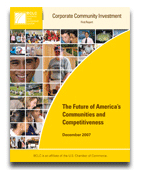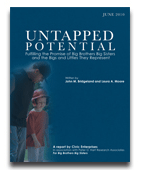ECONOMIC MOBILITY & THE FUTURE OF WORK
America's New
Business Plan
(Start Us Up Now)
If we’re going to create new jobs, we must support entrepreneurs. Yet, policymakers continue to prioritize big, established businesses over new businesses. The result: Entrepreneurship has remained effectively flat for 20 years, in part because women, people of color, and rural residents lack equal access to the tools needed to start new businesses.
Work, Skills, Community: Restoring opportunity for the working class
The authors of this report came together in the months after the 2016 election to develop a plan of action. We convened a group of scholars—half right-leaning, half left-leaning—then spent a year considering the causes of working-class distress and debating policy solutions. We struggled to find bipartisan consensus—far from easy in a year when American politics were more polarized than at any time in memory. And we have produced a set of recommendations that we hope Democrats and Republicans will come together to enact in Congress, arresting the decline in working-class communities and building bridges back to opportunity in the American mainstream.
Our definition of working class: people with at least a high school diploma but less than a four-year college degree living in households between the 20th and 50th income percentiles—roughly $30,000 to $69,000 a year for a household with two adults and one child. We include Americans of all races and ethnicities. A laid-off factory worker in Ohio or a Latina housekeeper in Los Angeles: when we look out across blue-collar America, we see more similarities than differences.
Our report begins with description: who makes up the working class, where do they live, how much education do they have, do they work, at what kinds of jobs, what do they earn, how much do they own? We also trace their growing problems—declining labor force participation, slumping marriage rates, single-parent families, opioid deaths—and map them.
The three chapters that follow contain our proposed solutions: ideas about creating jobs, increasing wages, drawing workers back into the labor force, revamping education and job training, bolstering communities and strengthening families.
Modernizing Unemployment Insurance for the Changing Nature of Work
THE ASPEN INSTITUTE’S FUTURE OF WORK INITIATIVE is a nonpartisan effort to identify concrete ways to address the challenges American workers and businesses face due to the changing nature of work in the 21st century. Established in 2015, the Initiative is driven by the leadership of Honorary Co-Chairs Senator Mark R. Warner and Purdue University President and former Governor of Indiana Mitch Daniels, Co-Chairs John Bridgeland and Bruce Reed. Executive Director Alastair Fitzpayne leads an Aspen Institute staff, based in Washington, DC. For more information, visit www.aspeninstitute.org/futureofwork.
Created in 1935, Unemployment Insurance (UI) is a central pillar of the social insurance system for American workers. The UI program — which is overseen by the U.S. Department of Labor and administered by the states — collects payroll taxes from employers to insure workers against unexpected job loss. Eligible workers who become unemployed through no fault of their own can receive temporary income support while they search for reemployment. In 2016, the program paid $32 billion to 6.2 million out-of-work individuals.
The Rise of the Expert Economy
Over the last quarter century, technology has led a democratic revolution in information, which is now cheap, immediate, boundless, and easy to search. So far, that vast universe of information has not made us much smarter in how we spend our time, choose our leaders, or solve our common problems. We’re exposed to more data than we can process, more facts than we can trust, more reality than we can verify. We share links, likes, pics, and cat videos. We use apps to share rides and spare rooms or find romantic partners. Yet by nature, we seem to share least what could help each other most: what we know best. The Information Age is by no means the Age of Wisdom.
The Economic Value of Opportunity Youth
In their early adult years, it is important for youth to gain additional skills through further educational, training, and work experience. Yet, many of America’s youth are neither enrolled in school nor participating in the labor market – they are not investing in their human capital or earning income. Their disconnection represents a significant loss of economic opportunity for the nation. is report examines the status of these ‘opportunity youth’. For the 16-24 age group, we estimate that at least 6.7 million (17%) are currently ‘opportunity youth’. These youth are disproportionately male and from minority groups, but substantial rates are found for all youth groups. Opportunity youth may have dropped out of high school or college and been unable to and work; may have been involved in the criminal justice system; may have mental or health conditions that have inhibited their activities; or may have care-giving responsibilities in their families.
Some opportunity youth are ‘chronic’: they have never been in school or work after the age of 16. Others are ‘under-attached’: despite some schooling and some work experience beyond 16, these youth have not progressed through college or secured a stable attachment to the labor market. We estimate a chronic opportunity youth population of 3.4 million and an under-attached opportunity youth population of 3.3 million. Both groups are failing to build an economic foundation for adult independence.
National Roadmap for Opportunity Youth
There are 6.7 million youth ages 16 to 24 – or almost 17 percent of their age group – who are out of school, out of work. These opportunity youth are not a homogenous group; they have unique stories and became disconnected for a variety of reasons. America must make reconnecting opportunity youth a national priority. In doing so, we need to set a bold goal for action that can be realized community by community, state by state, and across the nation. As a nation, we should set a goal to cut the number of opportunity youth in half by 2020.
Opportunity Road: America's Forgotten Youth
There are millions of youth ages 16 to 24 who are out of school and out of work. They cost the nation billions of dollars every year and over their lifetimes in lost productivity and increased social services. They also represent an opportunity for the nation to tap the talents of millions of potential leaders and productive workers at a time when america’s skills gap is significant. The central message of this report is that while these youth face significant life challenges, most start out with big dreams and remain confident or hopeful that they can achieve their goals; most accept responsibility for their futures; and most are looking to reconnect to school, work and service. They point the way to how they can effectively reconnect to education, productive work and civic life.
On behalf of Civic Enterprises and the America’s Promise Alliance, Peter D. Hart Research Associates undertook a national cross-section of opportunity youth in 23 diverse locations across the United States in August 2011 to learn about common elements in their personal histories and their lives today, and to explore opportunities to reconnect them to work and school. At the time of the survey, respondents were ages 16 to 24, neither enrolled in school nor planning to enroll in the coming year, were not working, and had not completed a college degree. In addition, they were not disabled such as to prevent long-term employment, were not incarcerated, and were not a stay-at-home parent with a working spouse.
The Economics of Investing in Youth Opportunity
The economic impact of opportunity youth is felt by the youth themselves, by taxpayers, and across all society. Opportunity youth are less likely to be employed and more likely to rely on government supports. They are in worse health and are more likely to be involved in criminal activity. Purely from an economic perspective -- leaving aside important questions of social equity -- opportunity is being lost on a large scale. The aggregate economic losses associated with opportunity youth are enormous. There are immediate losses during youth and there are long-term losses as these youth fail to prosper. These losses can be calculated from various perspectives: for the taxpayer and for society; by youth subgroups; by level of government; and for individual communities. To avoid perpetuating these losses over current and future cohorts it is critical to understand the policy context for opportunity youth.
Enterprising Pathways: Toward a National Plan of Action for Career and Technical Education
As other economies have superseded the U.S. in middle-class growth, the strength of our overall economy is in jeopardy. In order to succeed, our workforce needs preparation and skills. Reinvigorating the American workforce by providing multiple, opportunity-based pathways to the middle class will be critical to revitalizing our economy and strengthening America’s global competitiveness. The purpose of this report is to inform a national debate among business leaders, educators, policymakers, and the public about the role of career and technical education (CTE) in the United States.
Career and Technical Education: Five Ways that Pay
As jobs that require only high school or less have disappeared, post-secondary education and training on the job and in schools have become the gateways to the middle class. The education and training programs are commonly referred to as career and technical education (CTE). The American CTE system is unique, flexible, and responds well to changes in labor market conditions. Part One of this report explores in detail the five major CTE pathways at the sub-baccalaureate level. Part Two lists the occupations for which CTE prepares American workers.
Corporate Community Investment: The Future of America's Communities and Competitiveness
The U.S. Chamber of Commerce Business Civic Leadership Center (BCLC) estimates that businesses provide $6 billion to $8 billion annually in philanthropic contributions to communities across the country. But these community contributions are just the tip of the iceberg.
Report on the State of Corporate Community Investment
Over the past year, the Business Civic Leadership Center has conducted this research on two fronts: (1) by convening community-level, information-sharing, and partnership-building forums in eight regions across the country and (2) by partnering with the Center on Philanthropy at Indiana University to survey officials in companies of all sizes to analyze how they engage in their local communities. Contrary to the popular stereotype that companies shift operations swiftly from community to community, many choose to stay put in particular locations for years and invest significant dollars in those communities.
While the findings in Report on the State of Corporate Community Investment are not definitive, they do indicate that corporate community investment (CCI) is motivated by a desire to improve local competitive conditions and quality of life, "give back," and recruit and retain employees and customers. Our research findings lead us to believe that the future of how companies and their partners invest in local communities will be different than the past.
Untapped Potential
American children represent a great untapped potential in our country. For many young people, choices are limited and the goal of a productive adulthood is a remote one. This report paints a picture of who these children are, shares their insights and reflections about the barriers they face, and offers ways forward for Big Brothers Big Sisters as it undergoes a nationwide strategic planning process to initiate an engagement and advocacy strategy that will provide at-risk children with the tools they need to achieve success.
Thanks to progress made from 2000, 10.6 million lives have been saved from malaria. But 800 children still die from malaria every day. You can help be part of the effort to end malaria deaths. Go to: https://www.malarianomore.org.
Gracias a los progresos realizados entre 2001 y 2020, se han salvado 10.6 millones de vidas de la malaria. Pero aún mueren 800 niños de malaria cada día. Usted puede colaborar con la iniciativa para acabar con las muertes por malaria. Visite: https://www.malarianomore.org.
© 2023 by ITG
.jpg)





